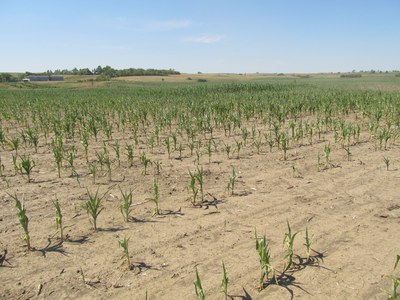Herbicide Applications with Hot Dry Conditions

Drought in Mercer County, 2017. Photo by NDSU
Be cautious with herbicide application during hot, dry weather.
July 2017
Richard Zollinger, Weed Specialist
Hot, dry conditions can influence weed control and crop injury from herbicides. All herbicides are influenced by environmental conditions. Herbicides generally are most effective when applied to vigorously growing plants at 70 to 85 degrees Fahrenheit. Most herbicide labels caution against treatment of plants growing under extreme environmental conditions or stress, because treatment of stressed plants can result in increased crop injury and/or decreased weed control.
Weeds growing under hot, dry conditions often become more tolerant to herbicides. Plants may develop a thicker wax layer on the leaf surface, which is a barrier to herbicide absorption into the plant. Herbicide movement within the plant will likely be reduced due to a slowed rate of translocation and metabolism. Consequently, application of herbicides under such conditions often results in reduced weed control.
Reduced weed control during hot, dry weather probably is the biggest concern with the application of systemic herbicides such as most Roundup (glyphosate), SU herbicides, phenoxy or growth regulator herbicides, POST grass herbicides like Assure II, Puma (fenoxaprop), Fusilade DX, Fusion, and Poast. Application of these herbicides early in the morning after the plants have recovered from the heat of the previous day should provide better weed control than afternoon or evening application. Addition of adjuvants (spray additives), when recommended, also may improve weed control from these herbicides under adverse growing conditions.
Most contact herbicides become more active as temperatures increase. Increased activity may provide improved weed control, but can also result in greater crop injury. Contact herbicides such as Aim, Atrazine, Basagran, Betamix, Betanex, Ultra Blazer, Bronate, Buctril, Cadet, Cobra, Flexstar/Reflex, Gramoxone, Liberty, Resource, Sencor, and Sharpen all need to be used with caution as temperatures increase to 85 degrees and above. Postpone application of these herbicides if temperatures exceed 90 degrees to reduce risk of crop injury,. However, good weed control with contact herbicides is dependent on timely application. The best control generally is achieved with thorough spray coverage (high spray volume) and application to small seedling weeds. Although waiting until temperatures subside will lessen the risk of crop injury, the weeds may develop beyond the optimum treatment stage if application is delayed too long. In some cases, application of reduced herbicide rates may be better than delaying application, even when temperatures are over 90 degrees.
Precautions can be taken to minimize the risk for injury with contact herbicides during hot weather. Use lower labeled rates rather than higher rates, even if attempting to control larger or less susceptible weeds. The activity of contact herbicides is increased on all plants at higher temperatures, so the weeds also will be more susceptible to the treatment.
The most critical time for crop injury following application of a contact herbicide is the first few hours after treatment. Therefore, injury can be minimized by applying the herbicide in the evening after the temperature has decreased. Evening application will allow several hours of moderate temperatures following treatment while morning application will be followed immediately by increasing temperatures.
Many contact herbicides are labeled for use with various additives. However, most additives also increase the chance for crop injury. Omitting the adjuvant or using the lower labeled rate of the recommended adjuvant will reduce injury potential from a contact herbicide applied at high temperatures.